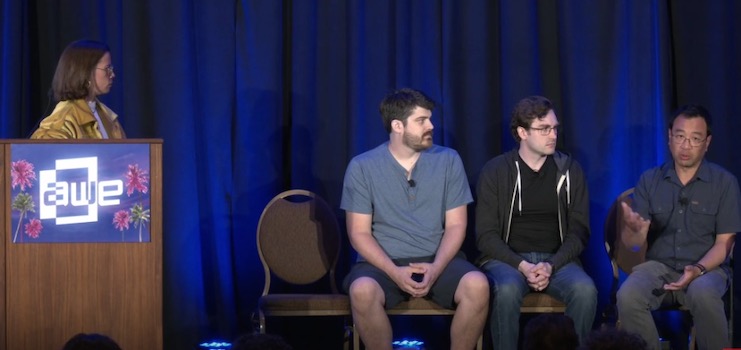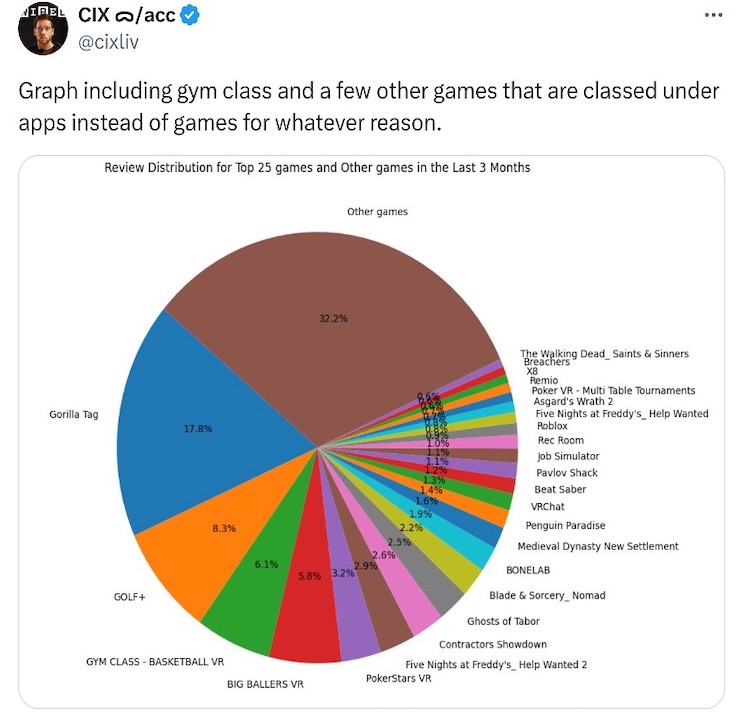
As someone who has followed the XR space for some time, I know firsthand that retention rates have always been a challenge. The original PC-based VR headsets Oculus Rift and HTC Vive were known to have trouble enticing users to come back regularly after the original excitement had worn off. Oculus co-founder Nate Mitchell at that time admitted that ‘expectations got ahead of themselves’ — and while Meta (then Facebook) remained tight-lipped, it was immediately obvious that to properly gauge the future of XR, sales numbers would not suffice. Just as important, if not more, are retention rates.
Other, more recent, estimates similarly did not inspire much optimism. AR Insider reported 31 percent of virtual reality users returning to VR at least once monthly, which was an improvement over the previous PCVR numbers but remained well below expectations — with the majority using VR less than once per month. Similarly, according to Meta’s internal presentation from 2023, Mike Rabkin told his employees that “sadly, the newer cohorts that are coming in, the people who bought it this last Christmas, they’re just not as into it,” suggesting retention numbers for Quest 2 were going down rather than up.
Steady Improvements
However, there is hope. The latest from Gorilla Tag developer Another Axiom suggests that VR might finally be overcoming this hurdle. For those unfamiliar, it was announced during this year’s AWE USA that the game has achieved an impressive milestone of more than one million daily active users. Its monthly retention rates are just as good, with three million users logging in at least once per month.
This promising shift is not entirely unexpected. In November of last year, Ryan Engle, the developer of Golf+, speculated around two to three million people use VR weekly. At GDC 2024, Chris Pruett, Meta’s Director of Content Ecosystem mentioned that Quest 3 has the highest retention rate of all Meta headsets. And now, thanks to Gorilla Tag’s success, we have another bit of good news.
The fact that currently, one game alone can pull such numbers is an important feat that deserves attention. To put that into perspective, it wasn’t that long ago that the entire Quest ecosystem was believed to have around a few million active users.

Extrapolating Gorilla Tag’s Success
Gorilla Tag is a phenomenon that deserves all the accolades but is not the only app on Quest that has found success, it stands alongside games like Beat Saber, VRchat, and Rec Room; productivity and media consumption apps; and creative tools. They all have their share of dedicated, returning users.
In the absence of any concrete numbers, let’s look at Gorilla Tag in terms of market share and try to extrapolate. At AWE 2024, Another Axiom mentioned they were the first app to hit 100,000 reviews (currently already at 111,000).
In his post on X, a developer and XR founder Cix, overlaid these two data points and concluded that the retention could be around five to six million DAU across all Quest devices (1 / 0.178 = 5.61). Going by the same token, the number of monthly users could be as high as sixteen to seventeen million (3 / 0.178 = 16.85).
These numbers might sound unrealistic so it’s important to remember that this is just a crude estimate. We have to assume that all Quest users behave similarly, that on average they leave the exact same number of reviews regardless of their age, experience, and other metrics — which, considering that Gorilla Tag caters predominately to a young gaming audience, is most likely not true.
We also must assume a strong correlation between user retention and their participation in the Quest review/rating ecosystem, which is not a given. In fact, there could be an inverse correlation — if Gorilla Tag players leave fewer reviews than an average user, while at the same time spending more time in the headset — this would skew the estimates significantly. Many other important variables also remain unknown.

Promising Prognosis
Even if the Gorilla Tag extrapolation is overly optimistic, it invariably points to continuous and steady improvement in retention rates. We could divide those estimates in half and the retention would still show an upward trajectory.
At the same time, we can see the continued dwindling of PC-based VR, evidenced by Steam’s concurrent user statistics. Some categories like simulators are doing well, but on average the numbers oscillate around 100,000 users daily. Tellingly, Gorilla Tag itself has on average less than 1,000 concurrent players on Steam.
There are many people who continue to believe that Meta Quests mostly just sit on the shelves collecting dust. That opinion is especially true among mainstream media outlets that tend to cater to a more general non-XR audience and because of that often gravitate toward conventional takes. Gorilla Tag’s milestone contradicts this sentiment and acts as a very promising prognosis for the future of XR use.
 Mat Pawluczuk is an XR/VR writer and content creator.
Mat Pawluczuk is an XR/VR writer and content creator.

